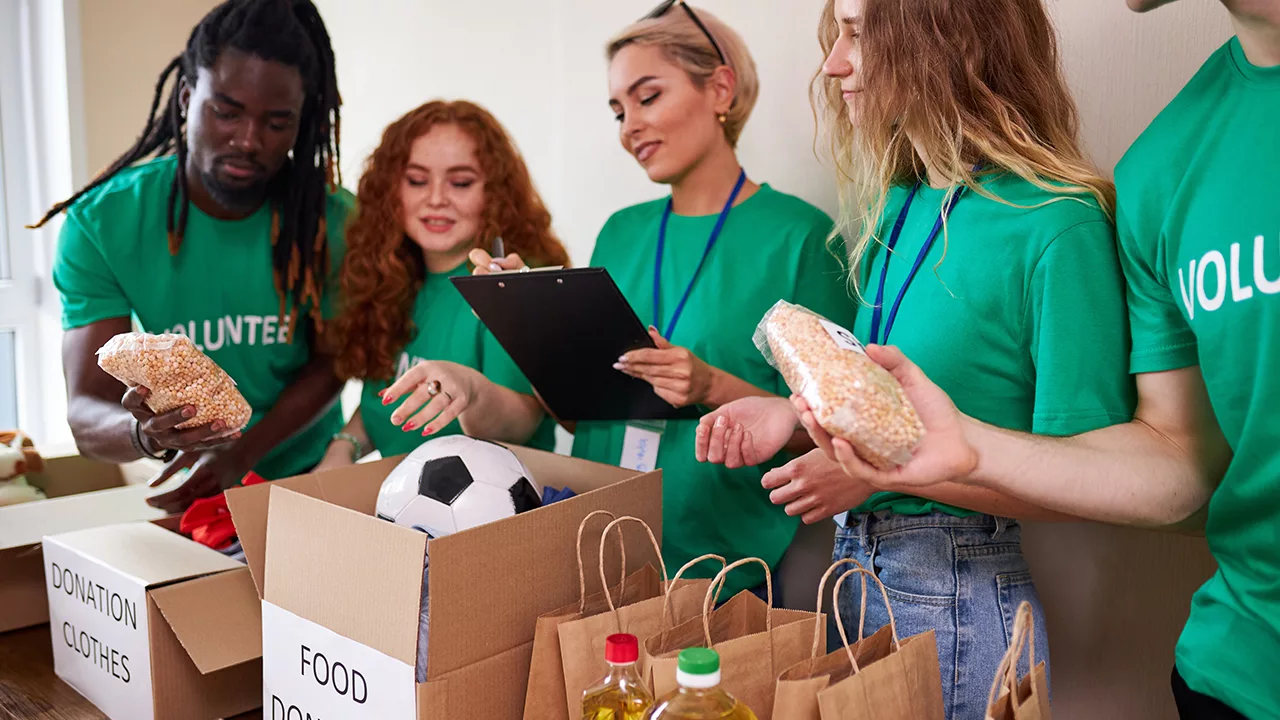Fundraising is the lifeblood of nonprofit organizations. Securing financial support from donors is essential to fulfilling their mission and making a positive impact on the communities they serve. This comprehensive guide will provide you with the knowledge, tools, and strategies needed to successfully attract and retain donors for your nonprofit. By understanding your target donors, developing a strong value proposition, creating a strategic fundraising plan, crafting compelling communications, building relationships, and evaluating your efforts, you can secure the financial support needed to thrive.
Understanding Your Target Donors
Understanding and evaluating your target donors is the first step to kickstart a successful fundraising campaign. By segmenting your audience, identifying their motivations, and understanding their demographics and preferences, you can tailor your efforts to resonate with prospective supporters.
Identifying Donor Segments
When we consider our donor landscape, four major categories come into focus: individuals, foundations, corporations, and government grants.
Individuals
Individual donors make up a diverse group, ranging from small-dollar supporters to major gift contributors. Their motivations for giving vary, but they often include personal connections, the potential for community impact, or possible tax benefits.
Private Foundations
Private foundations are typically set up by wealthy families. These foundations support nonprofits through grants, guided by a specific mission or focus areas. They present valuable opportunities for nonprofit organizations in search of funding.
Corporations
Corporations also play a significant role in our fundraising efforts. They may provide financial support, sponsorships, or in-kind donations. These businesses often pursue opportunities that align with their corporate social responsibility goals, leading to collaborations with nonprofits that work towards shared social causes.
Government Grants
Finally, we have government grants, offered by federal, state, and local government agencies. These grants are typically competitive and require adherence to specific guidelines. Nonprofit organizations must stay vigilant for these opportunities, ensuring alignment with their values and goals.
In sum, charitable organizations need to strategize and target those donor segments that best meet their desired outcomes and goals. By understanding and effectively engaging these various donor segments, nonprofits can successfully advance their missions.
Donor Motivations
Personal Connection
Donors may be drawn to support causes that have personally affected them or someone they know. For instance, NGOs collecting funds for flood-hit areas are most likely to gain donors who are in any way affected by the harrowing impact of natural disasters.
Community Impact
Donors often want to support organizations that make a tangible difference in their local communities. This requires an in-depth study of the targeted communities and eventually tracing down donors associated with the communities and their issues identified.
Tax Benefits
Charitable giving could be the best way to provide donors with tax deductions and other financial incentives.
Recognition and Prestige
Some donors may be motivated by the recognition they receive for their philanthropy, such as public acknowledgment (on social media or at live events) or inclusion in donor clubs.
Donor Demographics and Preferences
Age: Different age groups may have varying preferences for communication, engagement, and giving methods. Social media and text-to-give are now some of the most powerful giving tools of the younger generations.
Income Level: Donors at different income levels may have different giving capacities and expectations. Income levels may also be identified by evaluating the cost of areas where the prospective donors are residing.
Education: Donors with higher levels of education may be more likely to research organizations before giving and may value transparency and accountability. On this basis, nonprofit organizations can bring donors by targeting various educational institutes.
Location: Local, regional, and national donors may have varying interests and preferences for supporting organizations that serve their communities. Understanding the radius within which the nonprofit organization aims to build an impact helps identify the geographic locations of potential new donors. Maintaining a database with addresses and contact information further aligns the whole process.
Developing a Strong Donor Value Proposition
A strong value proposition is the golden key to attracting and retaining donors. Clearly define your mission and vision, demonstrate your impact, and communicate your unique selling points to make a compelling case for support.
Clearly Defining Your Mission and Vision
The identity of any organization lies in its mission and vision statements, both of which play crucial roles in attracting a relevant pool of donors.
The mission statement is a concise communication of your organization’s purpose. It identifies the population you serve and outlines the change you seek to create. A well-articulated mission and vision can resonate with potential donors, illustrating your dedication and the impact their contributions could make.
Demonstrating Impact
Success Stories: Share stories of the people, communities, or issues your organization has positively impacted to illustrate your work’s effectiveness. Stories shared through infographics, videos, and snippets from real-time fund-raising drives or events tend to give a clearer picture of the organization’s ethics and values.
Metrics and Data: Use quantitative data to show your organization’s progress toward its goals and the scale of your impact. Rolling out quarterly, bi-yearly, and annual reports with actual numbers and information is a foolproof method to develop trust between the organization and its existing and potential customers. The reports must be made available on all relevant platforms for board members and future donors.
Testimonials: Include quotes and first-hand experiences from beneficiaries, partners, and other stakeholders that speak to your organization’s effectiveness and value. It has never been a bad idea to include positive experiences shared by your collaborators, donors, or any other party associated with donation drives. It helps potential donors to establish a baseline on how valuable the experience could be for them.
Unique Selling Points
Highlight the innovative approaches or technologies your organization employs to address the problems you seek to solve. Adding infographics and stats while conveying unique selling points helps the audience form a relevant opinion about the organization. A strong and clear USP for nonprofits is a route to developing a positive perception among your target donors.
Also, showcase how your organization collaborates with other organizations or entities to increase your impact and reach. Nonprofit organizations must develop a strategy to build a portfolio in this case. Making your work available for your audience to see simply makes the entire procedure of targeting donors transparent enough.
Plus, emphasize your organization’s commitment to long-term solutions and financial sustainability. Again, displaying your previous projects for the audience is just as crucial here. Organizations can come up with engaging ideas to show the impact of their projects from the past.
Creating a Fundraising Strategy
Developing a comprehensive fundraising strategy is crucial for guiding your efforts and maximizing your results. Set SMART goals, create a fundraising calendar, allocate resources, and diversify your funding sources to optimize your approach.
Setting SMART Goals
Specific: Clearly define your fundraising objectives, such as a target amount or a specific project to be funded. Understanding your audience plays a pivotal role in aligning your goals and vice versa.
Measurable: Establish quantifiable indicators that will allow you to track progress and measure success. A step-by-step record of each project helps organizations understand where they stand and if there is any other step that needs to be taken to improve records.
Achievable: Set realistic goals based on your organization’s capacity, resources, and past performance.
Relevant: Ensure your fundraising goals align with your organization’s mission, vision, and priorities. Above all, your potential major donors should be able to resonate with the goals.
Time-bound: Assign deadlines to your goals to create a sense of urgency and facilitate progress tracking.
Developing a Fundraising Calendar
Organizing annual campaigns is a crucial aspect of our fundraising strategy. Regularly scheduled fundraising events, such as year-end appeals or spring campaigns, provide consistent opportunities for donors to give. It is essential to plan these campaigns for months, taking care to carefully define each planning process. Importantly, these campaigns must align with our organization’s philosophy, as this will resonate with our donors’ values and further inspire their generosity.
Next, let’s talk about special events. The collection of donations through engaging, entertaining events is a common and effective strategy employed by many nonprofit organizations. By planning and organizing events such as galas, charity runs, or auctions, you can create a rewarding experience for donors, who not only enjoy the event but also feel connected to the cause they are supporting.
Finally, the tracking of grant deadlines is very important. Timely application to grant opportunities can often be the lifeline that nonprofit organizations need to carry out their work. Many individuals and organizations follow pages and platforms with relevant information to keep themselves updated on upcoming opportunities. Being meticulous about these deadlines ensures we don’t miss out on any potential funding sources that could contribute significantly to our organization’s mission.
Allocating Resources
Staffing: Assign staff members or volunteers to specific fundraising tasks, such as prospect research, donor cultivation, or event planning. Regular training of the assigned staff members should also be on the priority list of organizations to stay on track.
Budget: Determine the financial resources needed for your fundraising efforts, including materials, technology, and personnel costs. Budgets may vary depending on the size and age of a nonprofit organization.
Technology and Tools: Invest in donor management software, online fundraising platforms, and other tools that can streamline your efforts and improve donor engagement. A one-time investment in relevant software goes a long way in the organization’s progress.
Diversifying Funding Sources
Prospecting New Donors: Actively seek out new potential donors through research, networking, and outreach efforts. You may use various social media platforms to achieve your goals in this regard.
Cultivating Current Donors: Encourage current donors to continue supporting your organization through regular communication, personalized engagement, and stewardship. Healthy relationships with existing donors can be established by maintaining contact through emails, SMS subscriptions, etc.
Exploring Planned Giving: Promote planned giving options, such as bequests, charitable trusts, or major gifts to encourage long-term support. Gift-giving practices help maintain a soft spot in your audience’s heart and also help in brand recall.
In-kind Donations: Solicit in-kind donations, such as goods, services, or expertise, to supplement your financial support.
Crafting Compelling Donor Communications
Effective donor communications are key to inspiring support and fostering relationships. Develop impactful messages, tailor your approach to different donor segments, and create visually engaging content to capture attention.
Developing Key Messages
Emotional Appeal: Evoke emotions by sharing powerful stories, images, or videos that illustrate the importance and impact of your work. Emotional appeals are a great way to attract donors, especially during the days when special occasions such as Thanksgiving, Easter, etc are near.
Urgency: Convey a sense of urgency by emphasizing pressing needs or timely opportunities for donors to make a difference. Such appeals work best when immediate attention is required, such as in natural disasters.
Tangible Outcomes: Clearly articulate the specific outcomes that donors’ financial contributions will help achieve, such as the number of people served or the tangible impact on a community.
Tailoring Messages to Donor Segments
Firstly, personalization helps your communication match each donor’s unique interests and giving history. It’s about directly connecting with each donor, making them feel seen and valued.
Secondly, a multichannel approach is key. By utilizing various communication platforms, like email, social media, and direct mail, you can maintain consistent and engaging contact with your donors, no matter where they are.
Lastly, prioritize relevance in your messaging. By understanding and addressing the specific motivations of different donor groups, you can craft resonating messages, creating stronger ties between donors and your organization.
Designing Impactful Visuals
Infographics: Create visually appealing infographics that convey complex information or data in an easily digestible format. Avoid complex words or charts that may distract from your message.
Videos: Make compelling videos that showcase your organization’s impact, share beneficiary stories, or provide a behind-the-scenes look at your work. Include shots from donation drives and real-time imagery of the communities where the impact was made. Most often, a before and after analysis of projects helps the audience understand the organization’s goals.
Social media graphics: Develop eye-catching graphics for social media platforms that encourage engagement and sharing. Keep your social media accounts up-to-date since a large audience is now found online.
Building Relationships with Donors
Cultivating lasting relationships with donors is essential for sustained support. Engage with your community through networking, donor cultivation events, and effective stewardship to build strong connections.
Networking and Community Engagement
Being actively involved in your community and professional network, as well as leveraging social media, are powerful strategies for connecting with potential supporters and raising awareness of your organization.
Participation in local events such as fairs, expos, or festivals offers an excellent opportunity to raise the profile of your organization and connect with potential supporters. These gatherings provide the perfect platform for one-on-one networking, which can significantly influence the perspectives of potential donors toward your organization and its cause.
Involvement in professional associations or nonprofit networks is another key strategy. Joining these groups enables you to build relationships with peers, potential donors, and field experts. By consistently communicating about your organization’s causes and projects, you can strengthen your standing in relevant areas and optimize the benefits derived from these professional networks.
Finally, the use of social media is an effective and cost-efficient tool for attracting donors. Engaging with potential supporters in social media groups or online forums related to your cause or community can significantly boost your organization’s visibility. By being an active participant across various social media platforms, your organization can increase its reach, boost awareness, and enhance recognition among potential supporters.
Donor Stewardship
Recognition and Appreciation: Acknowledge and thank donors for their support through personalized communications, public recognition, or special events. Sending a token of appreciation in the form of corporate gifting is a widely known idea to thank and respect your donors. Sometimes, even a phone call appreciating your major donors could work best.
Regular Updates: Keep donors informed about your organization’s progress, successes, and challenges through newsletters, emails, or social media updates.
Donor Surveys: Solicit donor feedback through surveys or interviews to better understand their preferences, expectations, and experiences with your organization. Organizations could roll out survey forms through social media platforms, emails, phone calls, SMS subscriptions, or conduct one-on-one meetings to collect authentic feedback. Evaluate the survey results and develop strategies to fill in any gaps identified. Carry out surveys periodically to constantly measure the quality of fund-raising campaigns.
Evaluating Fundraising Success
Monitoring and evaluating your fundraising efforts is crucial for continuous improvement and success. Establish key performance indicators (KPIs), track progress, and adjust your strategies based on data-driven insights.
Establishing Key Performance Indicators (KPIs)
Donor Retention Rate: Measure the percentage of donors who continue to support your organization from one year to the next.
Average Gift Size: Calculate the average amount donated per gift to gauge the effectiveness of your fundraising appeals.
Cost per Dollar Raised: Determine the efficiency of your fundraising efforts by comparing the costs associated with collecting donation amount to the total amount raised.
Monitoring and Adjusting Strategies
Effective fundraising management involves several essential practices that aid in constant evolution and improvement.
One such practice involves conducting regular progress reviews of your fundraising efforts. These periodic assessments allow you to gauge progress toward your goals and pinpoint areas that need improvement. Emphasizing transparency, it’s ideal that these progress reports are made publicly accessible. This transparent approach fosters trust and demonstrates accountability to your supporters.
Next, adopting a data-driven approach to decision-making is key. This means leveraging data and insights from your Key Performance Indicators (KPIs), donor feedback, and other sources to shape your fundraising strategies and tactics.
Finally, take lessons from both the challenges and successes experienced in your fundraising drives. Reflecting on these experiences helps refine your approach moving forward. By implementing decisions based on past challenges with a proactive approach, you can conserve time, effort, and costs, making your fundraising operations more efficient and effective.
Conclusion
Attracting and retaining donors is vital for nonprofit organizations to achieve their mission and create lasting impact. By understanding your target donors, developing a strong value proposition, creating a strategic fundraising plan, crafting compelling communications, building relationships, and evaluating your efforts, your organization can secure the financial support it needs to thrive. Remember that fundraising is an ongoing process that requires constant adaptation and improvement, so stay committed to learning, growing, and refining your approach for long-term success.



